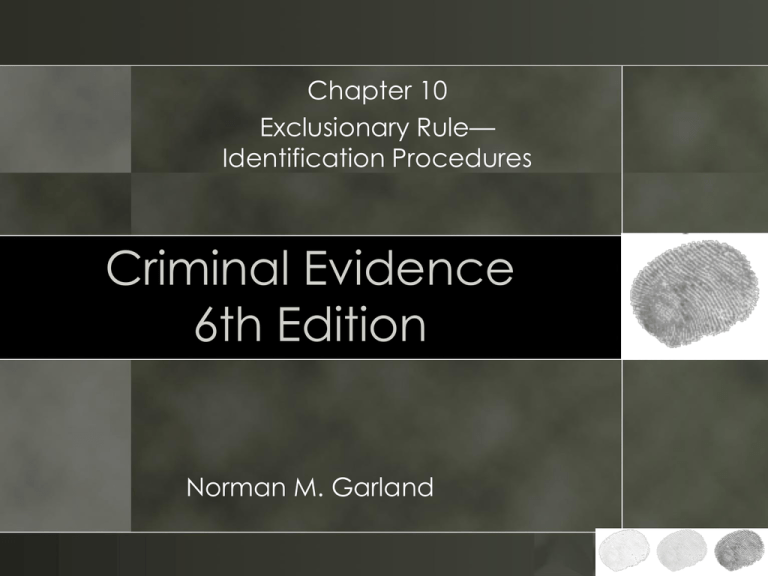
Chapter 10
Exclusionary Rule—
Identification Procedures
Criminal Evidence
6th Edition
Norman M. Garland
Identification Procedures and
the Right to Counsel
o The Sixth Amendment to the
Constitution states, in part: “In all
criminal prosecutions, the accused
shall . . . have the assistance of
counsel for his defense.”
© 2011 The McGraw-Hill Companies, Inc. All rights reserved.
Identification Procedures and
The Exclusionary Rule
o Both pretrial and in-court identifications
may be inadmissible if a defendant’s
Fourth, Fifth, Sixth, or Fourteenth
Amendment rights were violated during
the investigative identification
procedure.
© 2011 The McGraw-Hill Companies, Inc. All rights reserved.
The Three Basic Types of
Identification Procedures
1. Show Ups: one-on-one presentation
of a suspect to a victim or witness.
2. Lineups: presentation of similar
looking persons to a victim or witness.
3. Photographic Arrays: presentation of
a number of photos.
© 2011 The McGraw-Hill Companies, Inc. All rights reserved.
The Right to Counsel:
A Fundamental Right
o The United States Supreme Court has
held that the right to counsel at trial is a
fundamental right.
o This right applies to the states through
the Fourteenth Amendment Due Process
Clause whenever a defendant’s trial
may result in incarceration.
© 2011 The McGraw-Hill Companies, Inc. All rights reserved.
The Critical Stage Test for the
Right to Counsel
o As early as 1932, the United States
Supreme Court observed that “the
period from arraignment to trial was
‘perhaps the most critical period of the
proceedings . . .’ during which the
accused ‘requires the guiding hand of
counsel . . . if the guarantee is not to
prove an empty right.’”
oPowell v. Alabama, 287 U.S. 45, 57, 59
© 2011 The McGraw-Hill Companies, Inc. All rights reserved.
What is a critical stage?
o A critical stage begins at the initiation
of an adversarial judicial proceeding,
whether by way of a formal charge,
preliminary hearing, indictment,
information, or arraignment.
o Any pretrial event requiring the
presence of counsel can be a critical
stage, analogous to a trial, where the
accused may be overpowered by his
or her professional adversary.
© 2011 The McGraw-Hill Companies, Inc. All rights reserved.
The Test to Determine
a Critical Stage
o The test of a critical stage is whether at
"the trial itself . . . no substitute for
counsel” can be provided to a
defendant in the event that “a pretrial
confrontation is conducted in the
absence of counsel.”
oUnited States v. Ash, 413 U.S. 300 (1973)
© 2011 The McGraw-Hill Companies, Inc. All rights reserved.
United States v. Wade: Source of
Right to Counsel at Pretrial Lineup
o The Court held that the post-indictment
lineup is a critical stage of the
prosecution at which the accused is as
much entitled to the aid of counsel as at
the trial itself.
o The Wade decision extended the
exclusionary rule to post-indictment
pretrial lineups, where a defendant has
been denied his or her Sixth
Amendment right to counsel.
© 2011 The McGraw-Hill Companies, Inc. All rights reserved.
When Counsel Need
Not Be Present: First Case
o If a defendant has not been formally
charged with a criminal offense, he or
she is not entitled to the assistance of
counsel at an identification
proceeding.
© 2011 The McGraw-Hill Companies, Inc. All rights reserved.
When Counsel Need
Not Be Present: The Second Case
o When a suspect, who has not been
indicted or otherwise formally
charged, is placed in a lineup, counsel
need not be present.
© 2011 The McGraw-Hill Companies, Inc. All rights reserved.
Identification Procedures
and Due Process
o Even if no violation of the right to
counsel exists, an identification may
still be excluded.
o The core of the issues relating to
misidentification are the Due Process
Clauses of the Fifth and Fourteenth
Amendments.
o These clauses preserve the right to a
fair trial.
© 2011 The McGraw-Hill Companies, Inc. All rights reserved.
Effect of Illegal Pretrial Identification on
In-Court Identification
o It is possible for an out-of-court
identification to be illegal while the
identification made at trial is admissible.
o On the other hand, if the in-court
identification is so influenced by the
illegal out-of-court identification as to
be a product of it, then the in-court
identification will not be admissible
either.
© 2011 The McGraw-Hill Companies, Inc. All rights reserved.
The Test to Consider
o The test is whether or not the in-court
identification is sufficiently free of the
taint from the out-of-court
identification to be trustworthy.
o Moreover, any case involving a legally
questionable pretrial identification
inevitably involves the question of
whether or not the in-court
identification should be admitted.
© 2011 The McGraw-Hill Companies, Inc. All rights reserved.
Only Unnecessarily Suggestive
Pretrial Identifications Are Illegal
o The question is whether, under the
totality of the circumstances, the
identification procedure was
unnecessarily suggestive.
© 2011 The McGraw-Hill Companies, Inc. All rights reserved.
Stovall v. Denno
Issues of Suggestiveness in Identification
Apart from Right to Counsel
o The Court held that a pre- or post-indictment
identification procedure that is unnecessarily
suggestive and conducive to irreparable
mistaken identification violates the due
process rights of an accused.
o To determine when an identification procedure
is unnecessarily suggestive, the Court stated
that “a claimed violation of due process of law
in the conduct of a confrontation depends on
the totality of the circumstances surrounding
it.”
© 2011 The McGraw-Hill Companies, Inc. All rights reserved.
Neil v. Biggers
5-Factor Test for Suggestive
Identification Cases
1. The opportunity of the witness to view
the criminal at the time of the crime.
2. The witness’s degree of attention.
3. The accuracy of the witness’s prior
description of the criminal.
4. The level of certainty demonstrated by
the witness at the confrontation.
5. The length of time between the crime
and the confrontation.
© 2011 The McGraw-Hill Companies, Inc. All rights reserved.
Types of Suggestive
Identification Procedures
o Size of the Lineup or Array
o Collaboration Between Witnesses
o Police Instructions or Statements to
Witnesses
o Make-Up of the Lineup or Photo Array
o Different Appearance of the Accused
o Other Suggestive Procedures
Pertaining Solely to Photo Arrays
© 2011 The McGraw-Hill Companies, Inc. All rights reserved.
An Exception
o Even though the use of a single
photograph or show-up is highly
suggestive, the court will nonetheless
justify its use in certain emergency or
exigent circumstances, such as when
the witness is in danger of dying.
© 2011 The McGraw-Hill Companies, Inc. All rights reserved.
Police Instructions or Statements
to Witnesses
o Officers should not tell a witness that
the photo array or the lineup includes
a defendant already in custody since
the witness may then be more likely to
choose the person who most closely
resembles the person they observed,
rather than selecting no one at all.
© 2011 The McGraw-Hill Companies, Inc. All rights reserved.
Different Appearance
of the Accused
o The most important thing in creating a
lineup or photo array is that the lineup
or array includes persons matching the
defendant’s general physical
description.
© 2011 The McGraw-Hill Companies, Inc. All rights reserved.
The Test
o “The test is whether the photograph of the
accused, [or the defendant himself in a
lineup], matching descriptions given by the
witness, so stood out from all the other
photographs as to suggest an identifying
witness that that person was more likely to
be the culprit . . . .” U.S. v. Jakobetz
o “The individuals in the photographic display
and lineup [should be] of the same race,
possess similar physical features, and be
alike in size, age, and dress.” Salam v.
Lockhart
© 2011 The McGraw-Hill Companies, Inc. All rights reserved.
Other Suggestive Procedures
Pertaining Solely to Photo Arrays
o Different Type or Quality of Photos
o Contents on and Around the
Photographs
o Alteration and Disguise of the
Photographs
© 2011 The McGraw-Hill Companies, Inc. All rights reserved.
Determining the Reliability of a
Suggestive Identification
o The five factors of the Biggers case.
o Is the identification clothed with indicia
of reliability? Are there facts indicating
an identification is reliable?
© 2011 The McGraw-Hill Companies, Inc. All rights reserved.
What contributes the reliability?
o The longer the witness’s opportunity to
view the offender.
o The greater attention to the offender at
the time of the offense.
o The more detailed the initial
description from the witness.
o The greater the certainty
demonstrated by the witness.
o The shorter the length of time between
the crime and the lineup.
© 2011 The McGraw-Hill Companies, Inc. All rights reserved.
Biggers—The First Factor:
The Witness’s Opportunity to View the
Criminal at the Time of the Crime
o The general rule is that if the witness
had a good opportunity to view the
defendant, then even if the pretrial
identification was suggestive, it will be
admissible because the viewing
opportunity provided an independent
basis for the identification.
© 2011 The McGraw-Hill Companies, Inc. All rights reserved.
Biggers—The Second Factor:
Witness’s Degree of Attention
o The second factor is whether the
degree of attention the witness paid to
the suspect during the event was
sufficient that one could say that the
witness’s ability to identify the accused
in court was based on the
independent identification and not
upon an unnecessarily suggestive
identification procedure before trial.
© 2011 The McGraw-Hill Companies, Inc. All rights reserved.
Police and the Second Factor
of Biggers
o Police officers pay a higher degree of
attention to details than a lay witness
because of the special training they
receive in observational techniques.
© 2011 The McGraw-Hill Companies, Inc. All rights reserved.
Biggers—The Third Factor:
Accuracy of the Description
o There is no set rule for determining how
accurate an initial description of the
defendant must be in order to find an
independent basis to show the
identification was reliable.
o The courts tend to look at whether or not
the witness was able to approximate
the defendant’s age, build, height,
weight, skin color, clothing, and any
other physical characteristics.
© 2011 The McGraw-Hill Companies, Inc. All rights reserved.
Biggers—The Fourth Factor:
Level of Certainty Demonstrated by
the Witness at the Confrontation
There are two issues surrounding the
certainty of a witness:
oThe degree of certainty required to
support the admissibility of an
identification.
oThe point at which the witness
became certain.
© 2011 The McGraw-Hill Companies, Inc. All rights reserved.
Biggers—The Fifth Factor:
Length of Time Between the Crime
and the Confrontation
o The shorter the time interval between
the crime and the identification, the
more reliable it is.
o Nonetheless, a long interval alone is
usually not enough to invalidate an
otherwise seemingly reliable
identification.
© 2011 The McGraw-Hill Companies, Inc. All rights reserved.
Eyewitness Evidence: A Guide
for Law Enforcement
o In 1999, the U.S. Department of Justice released
the Guide that suggested ways in which
eyewitness testimony can become more
reliable. In 2001, New Jersey was the first state
to adopt the recommendations, which include
suggestions on:
o Use and presentation of fillers in a lineup
o Witnesses instruction on viewing a lineup
o Viewing of photos by a witness
o Instructions to all present at a lineup to avoid
influencing the witness selection
© 2011 The McGraw-Hill Companies, Inc. All rights reserved.










